It was not unusual for a member of Moscow’s business elite to become a patron of the arts in late imperial Russia. The reforms of the 1860s had turned Tsarist society upside down, and the burgeoning number of young industrialists who suddenly found themselves very wealthy invariably emulated their aristocratic forebears by buying paintings. Art collections began springing up in Moscow like mushrooms in a forest as merchants sought paintings for the walls of their newly acquired mansions, and relaxation from the hard work of doing business. It was also not unusual for Russia’s pre-Revolutionary oligarchs, unfettered by received ideas about what was worthy of collecting, to buy paintings by living artists. Thanks to Pavel Tretyakov, the purchase of modern Russian art had become an eminently respectable, even fashionable activity; his brother Sergei’s more traditional collection of 19th-century Western European painting also included some contemporary works. It was, however, unusual for Moscow merchants to buy contemporary paintings by the most trailblazing members of the French avant-garde. Of the small number of collectors who were to become habitués of the bold Paris galleries which sold them, only one went on to open up his collection to the public, in an act of philanthropy that would have lasting consequences for the future of Russian art. His name was Sergei Shchukin.
The Russian art world was ripe for a change of direction by the end of the 19th century, and it seems fitting that Shchukin bought his first Monet in 1898, the year of Pavel Tretyakov’s death. The previous year, a pioneering article in a popular Russian magazine about the current state of Western painting by Igor Grabar had strengthened Shchukin’s resolve to move away from the rather tame Russian canvases he had collected to date, and he purchased instead a handful of works by Charles Cottet, Lucien Simon, Jean-Louis Forain and Frits Thaulow. Then, in the spring of 1898, during a visit to Paris, he paid a visit to Paul Durand-Ruel’s gallery in the Rue Laffitte in the company of his brother Pyotr, also an ardent collector (although mostly of Russian antiquities). According to Shchukin’s biographer Natalya Semyonova, each bought recently completed paintings by Pissarro, Sergei settling on his Avenue de l’Opéra and Pyotr choosing Place du Théâtre Français (both 1898). On this occasion their cicerone was their Moscow relative Fyodor Botkin, who had been trying to carve out a career as a painter in Paris for the past five years, and was acquainted with the leading dealers. But it was Sergei and Pyotr’s erudite and cosmopolitan younger brother Ivan who played the decisive role in shaping their tastes at this stage. A Moscow University graduate and flamboyant art fanatic who had contributed newspaper articles under the pseudonym of Jean Brochet, as ‘Ivan Shchuka’ translates into French (‘John Pike’), he had given up his share in the family business, and since 1893 had also been resident in Paris. As well as giving lectures on art, religion and philosophy, and collecting works by the Impressionists, he presided over a high-profile weekly salon at his home on the Avenue de Wagram which attracted the likes of Rodin, Degas, Redon, and Huysmans, dealers such as Durand-Ruel, and notable expatriate and visiting Russians.
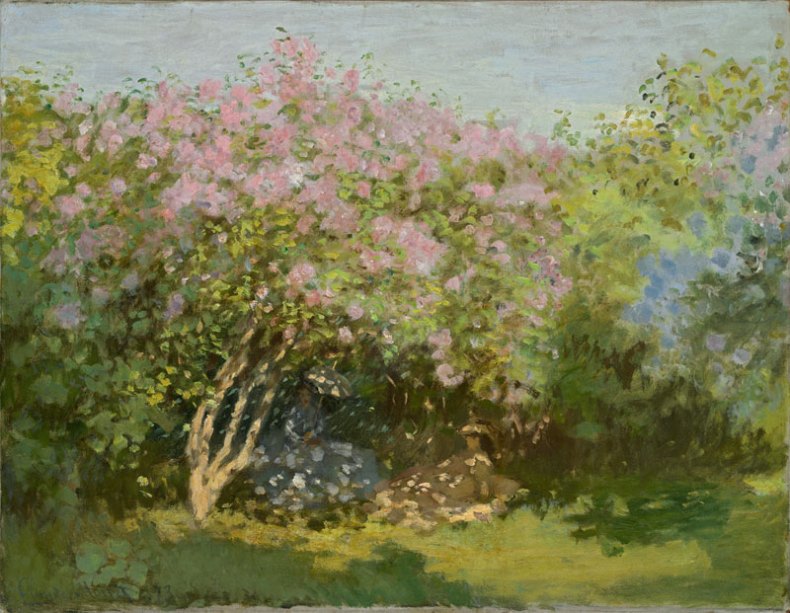
Lilas au soleil (1872–73), Claude Monet. Pushkin State Museum of Fine Arts, Moscow. Museum of New Western Art, Moscow / © Pushkin State Museum of Fine Arts
Later that same year, in November 1898, Ivan purchased on his brother’s behalf one of Monet’s 39 Rochers de Belle-Île, dating from 1886. Then a few months later, in February 1899, Shchukin came back to Paris himself to buy Lilas au soleil (1872–73). He was hooked. Over the next five years he would acquire another 11 paintings by Monet, dating from different periods. The gamble that Durand-Ruel had taken with the Impressionists certainly began to pay off in the 1890s, after a successful exhibition in New York enabled him to open a second permanent gallery there. Nevertheless, the French state still branded the Impressionists as charlatans when refusing a bequest of 60 canvases in 1894, and, with the notable exception of Kandinsky, the Petersburg and Moscow public was shocked by the handful of their canvases included in an 1896 exhibition of French art held to celebrate the Franco-Russian Alliance. Shchukin, a man of great sangfroid, quickly developed a reputation in Moscow for his audacious collecting, which often demanded considerable personal courage on his part. In 1903, he graduated from Monet and Degas to the post-Impressionists, and started buying Cézanne, Van Gogh, and Gauguin. Not content with hanging such scandalous paintings in his home, he was keen to show them off to visitors, supremely confident of their artistic worth; he relished the furious indignation and ridicule they provoked from his more conservative dinner guests. An unquenchable thirst for the new was something he shared with his younger contemporary, the sophisticated aesthete Sergei Diaghilev, who was based in the more cosmopolitan world of St Petersburg. Between 1898 and 1904 Diaghilev published The World of Art, the first international modernist journal in Russia, and then started working in the opposite direction to Shchukin by exporting avant-garde Russian culture to Paris through the reinvention of ballet.
Shchukin’s small stature, unprepossessing physical appearance, and pronounced stammer initially attracted unkind remarks from the Parisian art world, but his unerring critical acumen, coupled with his prodigious buying power, soon brought him the respect of the artists he patronised and their dealers. It was an unlikely outcome for the sickly third son of one of Moscow’s patriarchal merchant dynasties of whom little had been expected. Shchukin’s journey into the heart of the French avant-garde is also testament to the astonishing transformation of Russia’s previously conservative, pious, poorly educated and inward-looking merchant class. It was typical that his father Ivan, who made a fortune in textile manufacturing, came from an Old Believer background, had 10 children, and bought neither books nor paintings; but he loved Italian opera and sent his eldest sons to study business abroad. It was similarly typical that his mother Ekaterina Botkina also came from a tea-trading merchant family, but she and her nine brothers grew up fully integrated into Moscow’s aristocratic and artistic intelligentsia – she taught her children French. Sergei, born in 1854, was schooled with his sisters at home due to his delicate constitution, but a vegetarian diet and regular exercise led to him outliving nearly every member of his family. As an adult he continued to sleep with open windows, even during Moscow winters, which meant brushing off regular sprinklings of snow in the morning. After studying at a commercial academy in Germany he also confounded expectations by taking over ‘I.V. Shchukin and Sons’ when his father died in 1890. The combination of business sense, ambition and impulsive risk-taking which Sergei Shchukin brought so successfully to the production of textiles also characterised his habits as a collector of art.
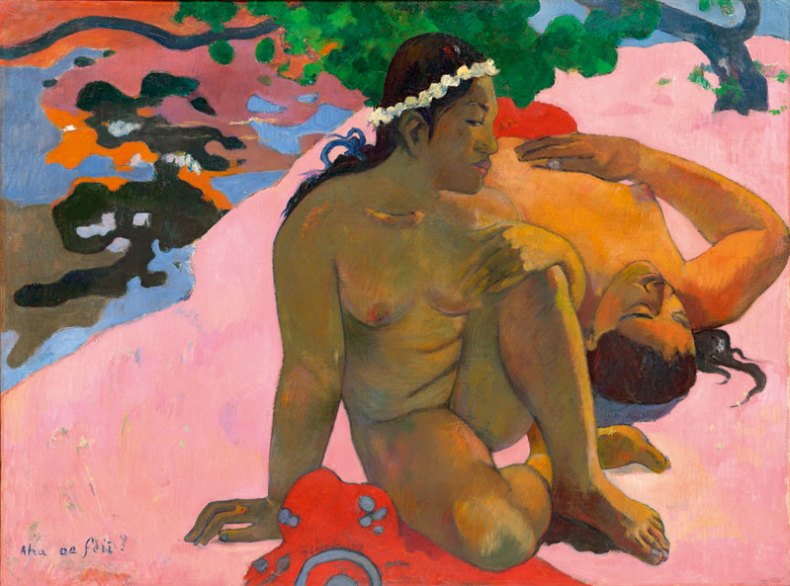
Aha oe feii? (1892), Paul Gauguin. Pushkin State Museum of Fine Arts, Moscow.
There was also a link between the exotic new fabrics from Central Asia and Persia, which expanded the frontiers of Shchukin’s trade, and his attraction to the intense colours of Gauguin’s late paintings, which became the subject of his second infatuation. While Gauguin was exploring new artistic worlds in Tahiti, Shchukin and his wife Lydia were encountering Egypt and India, their wanderlust stimulated by earlier travels to Turkey and Greece which they embarked on after their four children were born. Shchukin’s father had given the couple the Trubetskoy family’s elegant former mansion when their son Ivan was born in 1886, and its enfilade of sedate old-world interiors, which the new owner left untouched, became a series of incongruous galleries for his radical art collection. After Shchukin had spent time getting to know his new acquisitions privately in his study, the sombre walls of the oak-panelled gothic-style dining room were gradually lit up by the tropical warmth of Gauguin’s Tahitian masterpieces, Vairaumati te ioa (1892) and Aha oe feii? (1892). The Gauguin retrospective at the Salon d’Automne in 1906 featured 225 of his paintings, and Shchukin impulsively bought seven from the Galerie E. Druet on the rue du Faubourg-Saint-Honoré. The large Rupe Rupe (1899) would form the centrepiece of what the critic Yakov Tugenkhold later described as ‘a great fresco, an iconostasis’, in which over a dozen of Gauguin’s beautiful canvases were hung so close together that ‘at first, one does not even notice where one picture ends and the next begins’.
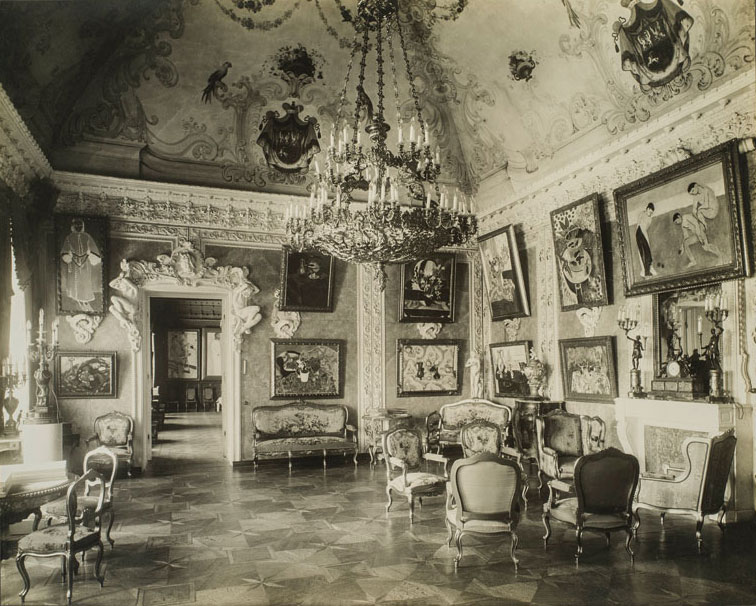
Pink Drawing Room (known as the Matisse Room), in Sergei Shchukin’s house, the Trubetskoy Palace, Moscow
The reference to the traditional wall of icons in a Russian Orthodox church is instructive, as Shchukin’s thirst for ever more challenging art was partly fuelled by a desire to sublimate feelings of deep personal grief. In November 1905, in the wake of the disastrous Russo-Japanese War and the disturbances following the events of ‘Bloody Sunday’, the Shchukins’ 17-year-old son Seryozha disappeared – his body was found in the Moscow River five months later. In January 1907 Shchukin suffered the death of his wife Lydia after a short illness, which was followed, exactly 12 months later, by the suicide of his brother Ivan, whose extravagant lifestyle and new-found obsession with old Spanish masters had led him into debt. In 1908 Shchukin offered the collector Gustave Fayet such an enormous sum for two of his Gauguin paintings (more than Fayet had paid for his entire collection) that he was able to buy a small château on the proceeds. Shchukin bought his last work by Gauguin two months after his second son Grigory shot himself in January 1910. By the time the masterpiece Te Arii Vahine (1896) arrived in Moscow later that year, there were 16 works by Gauguin in his collection.
Shchukin’s absorption with Gauguin overlapped with his passion for Matisse, which was indubitably the most important in his art-collecting career. It began with the monumental La joie de vivre, a key Fauvist work that Matisse first exhibited to public outrage at the Salon des Indépendants in March 1906. In this case Shchukin could not put into practice his principle of immediately buying every painting he experienced a ‘psychological shock’ in front of, as it had been sold to his rivals Leo and Gertrude Stein. But he requested a meeting with the artist via Ambroise Vollard, another of the dealers from whom he regularly bought works. That May he bought Vaiselle sur une table (1900) during a visit to Matisse’s studio, warning the artist that he would keep it only if he found he could live with it for several days. Shchukin’s patronage began in earnest in 1908, when he reserved La Desserte, Harmonie en rouge (1908) even before it had been completed, and at one stroke brought Matisse’s life of penury to an end. In 1909, as a result of their ensuing correspondence and warm friendship, Shchukin commissioned Matisse to paint two enormous panels for the main staircase in the Trubetskoy Palace. The naked figures in La Danse and La Musique (1910) caused a scandal at the Salon d’Automne that year, and initially even Shchukin baulked, but he rapidly changed his mind. In 1911, when Matisse came to Moscow to install the panels, he also supervised the hanging of the 21 of his paintings Shchukin had collected to date. He decided that they should all be relocated to the 18th-century style interiors of the ‘Pink Drawing Room’, where their riot of bright colours was set against its pale green walls, pink ceiling and crimson carpet. This room, which Shchukin called his ‘fragrant and sometimes poisonous but always beautiful hothouse of orchids’ became his favourite.
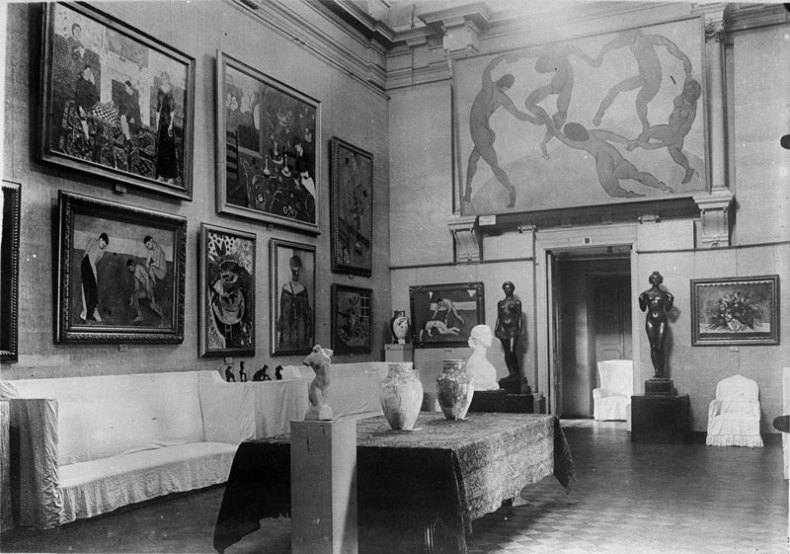
Interior of Sergei Shchukin’s house, showing Henri Matisse’s La Danse (1910).
It was Matisse who took Shchukin to Montmartre to meet Picasso in the autumn of 1908, which led to him purchasing Picasso’s early cubist painting Femme tenant un éventail (1907) from Clovis Sagot in the spring of 1909. Having bequeathed his collection to the Tretyakov Gallery after his wife’s death, Shchukin had by this time already started opening it to the public, and the impact on the Russian avant-garde was profound. Thanks to Shchukin’s extraordinary ability to select only representative masterpieces, Russian artists such as Natalia Goncharova, Mikhail Larionov, Kazimir Malevich, Vladimir Tatlin and others among their revolutionary contemporaries were able to acquire an immediate understanding of the latest and most important developments in modern art without even having to go to Paris. Shchukin eventually owned 38 works by Matisse, including Les Poissons rouges (1912), and his patronage would have continued had the First World War not intervened. The 225 items listed in the catalogue compiled in 1913 also included 50 paintings by Picasso (Shchukin owned the largest collection of his work anywhere in the world at that time), and several by André Derain, who became his final enthusiasm.
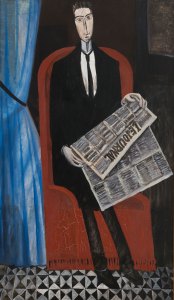
L’Homme au journal (1911–14), André Derain. State Hermitage Museum, St Petersburg.
Just before the outbreak of war, Shchukin had married for the second time, and in August 1918 he left Bolshevik Russia in secret, eventually settling with his wife and their young daughter in Paris, having bid farewell to both his business and his paintings. A few months later his collection was nationalised, and it opened to the public as the State Museum for New Western Painting No. 1 in May 1920. Two years later it was merged with the State Museum for New Western Painting No. 2, becoming known as the State Museum of New Western Art, which comprised the much larger collection put together between 1903 and 1914 by Shchukin’s fellow merchant patron Ivan Morozov, and that of Morozov’s deceased elder brother Mikhail. In 1928, Shchukin’s paintings were physically moved out of the old Trubetskoy Palace, with some even being transferred to the Hermitage in Leningrad in the early 1930s. By the time Shchukin died in 1936, as an emigré in straitened circumstances, unable and unwilling to continue his vocation as a major collector of new art, his name had virtually disappeared in Russia. In the harsh anti-cosmopolitan climate inaugurated by Stalin at the conclusion of the Second World War, it became dangerous even to mention Shchukin’s name. The State Museum of New Western Art never reopened, and the Shchukin and Morozov collections were divided by curators anxious to prevent their destruction, with the more avant-garde works going to the Hermitage and the rest allocated to the Pushkin Museum in Moscow. It was only after Stalin’s death that some of the paintings began to be displayed again, but their provenance remained a tightly-kept secret until the era of perestroika and glasnost.
The exhibition ‘Icons of Modern Art. The Shchukin Collection’, curated by Anne Baldassari, and opening at the Fondation Louis Vuitton Paris this autumn (22 October–20 February, 2017), will perform several important functions. Firstly it will become possible to distinguish Shchukin’s collection from Morozov’s, with which it has hitherto been inextricably linked, and thus fully appreciate the brilliance and consistency of his artistic judgement. Morozov also bought important paintings, but collected slightly in Shchukin’s shadow by starting later, and commissioning Fruits et Bronze (1910) from Matisse only after seeing Shchukin’s La Desserte, Harmonie en rouge in 1908. Unlike Shchukin he relied on a team of advisers, and never opened his collection to the public. The juxtaposition of paintings from Shchukin’s collection with selected works by the pre-Revolutionary Russian avant-garde will serve to highlight the remarkable role this self-effacing and quite austere man played in the modern movement by promoting the work of some of its greatest exponents. Maybe then, the name of Sergei Shchukin will finally become as well known as that of other important collectors of modern art like Peggy Guggenheim. It fully deserves to be.
‘Icons of Modern Art. The Shchukin Collection’ is at the Fondation Louis Vuitton from 22 October–20 February 2017.
From the September issue of Apollo: preview and subscribe here.
Unlimited access from just $16 every 3 months
Subscribe to get unlimited and exclusive access to the top art stories, interviews and exhibition reviews.

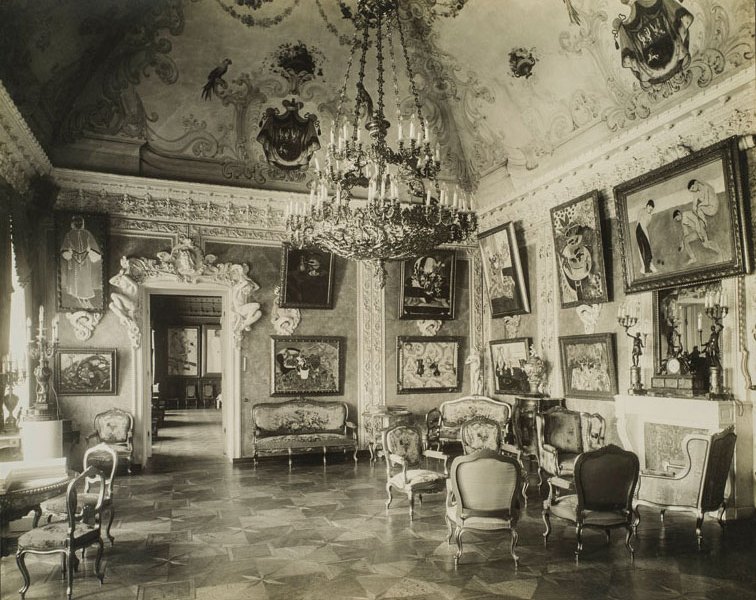
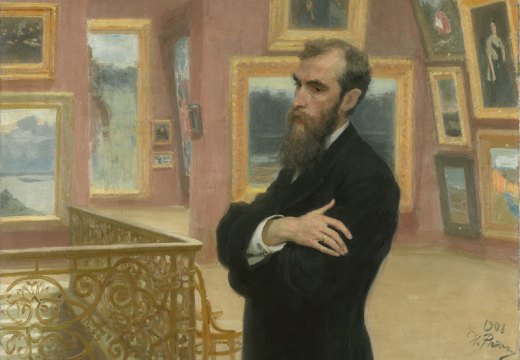
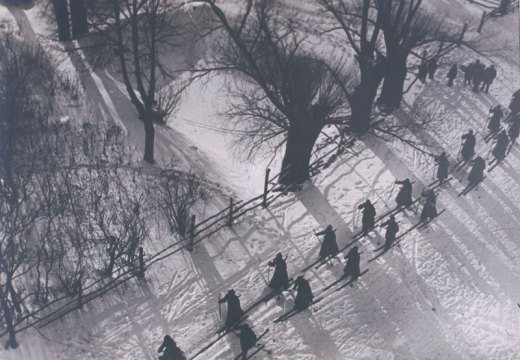
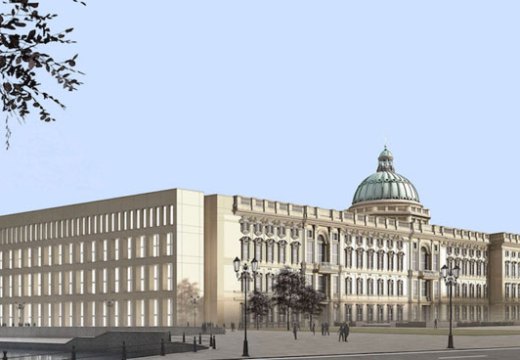









![Masterpiece [Re]discovery 2022. Photo: Ben Fisher Photography, courtesy of Masterpiece London](http://www.apollo-magazine.com/wp-content/uploads/2022/07/MPL2022_4263.jpg)
Why are fathers so absent from art history?